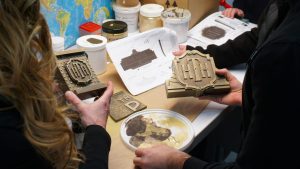DAPs Magic Disney News – PRESS RELEASE

Neverland, a fictional world in the Peter Pan movie, may be a state of mind, or hidden in the cosmos. To get to the place where you can never grow up, Peter Pan says to fly to the “second star to the right, and straight on ’til morning.”
In the Orion constellation, if you start from the left of the famous hunter’s belt, then take a right at the second star and head straight to a shimmering star-forming cloud, you’ll arrive at the great nebula of Orion.
This tangle of dusty clouds and newborn stars is showcased in a new view from NASA’s Wide-field Infrared Survey Explorer, or WISE.
The Orion hunter is visible in evening skies throughout the world from about December through April. The constellation appears tranquil and still to the naked eye, but lying in its sword, at what appears to be a slightly fuzzy star, is a turbulent cauldron of stellar birth.
WISE scanned the whole sky in infrared light, capturing an expansive view of this dynamic region, called the Orion nebula. The telescope picked up the infrared glow from dust heated by newborn stars. The colors green and red highlight this warmed dust, while the white regions are the hottest. Massive stars burned through the dust, carving out cavities, the largest of which is seen at the center of the picture.
Unlike Neverland, stars in the Orion nebula and throughout the cosmos do grow up. As they age, they sprinkle the universe with dust and other ingredients needed for solar systems like ours to form.
NASA’s Jet Propulsion Laboratory, Pasadena, Calif., manages, and operated, WISE for NASA’s Science Mission Directorate. The spacecraft was put into hibernation mode in 2011, after it scanned the entire sky twice, completing its main objectives. Edward Wright is the principal investigator and is at UCLA. The mission was selected competitively under NASA’s Explorers Program managed by the agency’s Goddard Space Flight Center in Greenbelt, Md. The science instrument was built by the Space Dynamics Laboratory in Logan, Utah. The spacecraft was built by Ball Aerospace & Technologies Corp. in Boulder, Colo. Science operations and data processing take place at the Infrared Processing and Analysis Center at the California Institute of Technology in Pasadena. Caltech manages JPL for NASA.
More information is online at http://www.nasa.gov/wise and http://wise.astro.ucla.edu and http://jpl.nasa.gov/wise.





